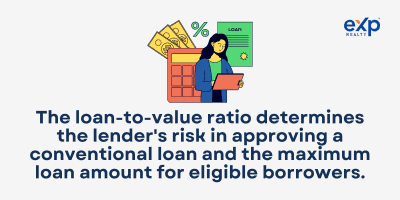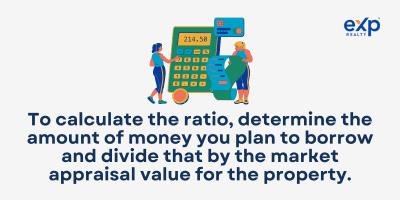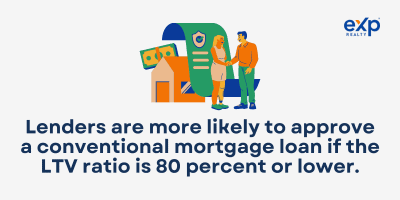The loan-to-value ratio is an imperative calculation that mortgage lenders use when approving mortgage loans and different loan types. The calculation allows each lender to determine the risk in approving a conventional loan and the maximum loan amount for eligible borrowers.
The loan-to-value (LTV) ratio will help determine your monthly mortgage payments. Further, a high-LTV ratio loan is generally a higher-risk basic loan. As such, higher-risk borrowers end up with a larger interest rate.
In these cases, the mortgage lender may sometimes require the borrower to purchase private mortgage insurance to reduce the risk for the lender.
Are you ready to learn more about the LTV ratio and how it impacts your home-buying experience? Keep reading to learn more about how to calculate the LTV ratio and its effects on buying a house.
Understanding the Loan-to-Value (LTV) Ratio
When calculating conventional mortgages, lenders use the LTV ratio to determine loan eligibility and whether to offer lines of credit to a borrower. It will help borrowers figure out how much down payment to put down when buying a property.
You can calculate the loan to value ratio using the loan amount and dividing it by the property’s total value. Lenders tend to rely on appraised market values of homes to determine the property value. The loan-to-value ratio will also help new homeowners find out their overall mortgage rate, including the interest rate. Then, home buyers can figure out their monthly payments.
Several factors impact the loan-to-value ratio, including:
- The amount of the down payment
- The final purchase price of the property
- The market appraisal values lenders consider
Home buyers looking to gain eligibility for a home equity loan, a line of credit, or any type of mortgage program will need to have a good LTV ratio. That ratio can determine home buyers’ eligibility for these home purchase loans. Essentially, the lower the LTV ratio is, the better the lender feels about lending the funds. Essentially, a smaller ratio ensures lower risk.
Much like the type of loan can vary, LTV ratios also come in different types. Various kinds of LTV ratios include:
- Purchase LTV
- Refinance LTV
- Cash-out refinance LTV
The purchase LTV ratio is meant for mortgage loans for those who recently bought a house. The refinance LTV ratio is used when a homeowner attempts to get a refinance loan to lower their interest rate. A cash-out refinance loan to value ratio is needed when a homeowner wants to change their home’s equity into a cash sum via a cash-out refinance loan.
How Do You Calculate the Loan-to-Value Ratio?
The loan-to-value ratio is relatively simple to calculate. You will need to take the loan amount that the borrower needs by the appraised property value. The loan-to-value ratio is necessary for securing the loan for purchasing your asset.
Essentially, the loan-to-value ratio helps lenders measure the financial or debt obligations of the borrower concerning the property value.
Before submitting a loan application, a borrower may want to calculate the LTV ratio. To calculate the ratio, you need to determine the amount of money you plan to borrow and divide that by the market appraisal value for the property.
In the eyes of lenders, the LTV ratio helps decide whether to lend different types of loans. It also helps determine the interest rate that each individual lender can offer. Also, the loan-to-value ratio helps lenders determine whether to offer private mortgage insurance and how high the premium will reach.
Acceptable LTV Ratios
Usually, home loans cannot have a higher loan-to-value ratio than 80 percent if you want to avoid paying for private mortgage insurance (PMI). Those with a ratio above 80 percent may need to pay for private mortgage insurance. That will add a yearly payment of anywhere from 0.5 to 1 percent on top of the home loan amount.
Furthermore, you will only gain the lowest possible interest rate from a lender if your loan-to-value ratio is 80 percent or lower. If a borrower has an LTV ratio of 95 percent, they are likely to pay a full percentage higher interest rate as compared to a home buyer with an LTV ratio of 75 percent.
Limitations of LTV Ratios
While LTV ratios can help determine whether you as a home buyer will get approval for a mortgage loan, they are not the only determinant. A good loan-to-value ratio will not guarantee whether you get your home loan approved, as lenders look at multiple factors. For instance, home buyers often require a steady income, excellent credit scores, and often a full-time job to gain a loan.
Furthermore, a bad LTV ratio of 95 percent or more is likely to lead a lender to decline a mortgage approval for a home buyer. Essentially, a high LTV ratio is considered risky for the lender. Lenders believe it may lead a borrower to struggle to cover monthly mortgage payments, which may then bring about a foreclosure on the house.
Impact of LTV on Mortgage Options
The LTV ratio can impact the loan term of a variety of different types of mortgage loans. Additionally, the LTV ratio also affects the availability of many loan types. For instance, lenders are more likely to approve a conventional mortgage loan if the LTV ratio is 80 percent or lower.
It is possible to find lenders who will approve a conventional mortgage loan if one’s LTV ratio is as high as 97 percent. Fannie Mae uses a 97 percent loan-to-value ratio for first-time home buyers with a low down payment.
FHA loans, however, are perfect for borrowers who have a high LTV ratio. FHA loans only need a low 3.5 percent down payment and work for properties with a 96.5 percent loan-to-value ratio or lower.
Another mortgage option, the adjustable-rate mortgage loan, requires a minimum of 3 to 5 percent in a down payment of the overall home purchase price. To qualify for an adjustable-rate mortgage loan type, a home buyer needs to have an LTV ratio of 95 percent or lower.
A 15-year or 30-year fixed-rate mortgage loan is the most standard type for homeowners. As such, most lenders prefer home buyers seeking a fixed-rate mortgage to have an LTV ratio of no more than 80 percent.
Furthermore, lenders may require a mortgage insurance policy for home buyers who have an LTV ratio above 80 percent. The higher the loan-to-value ratio is, the higher a home buyer’s private mortgage insurance premium payment will reach.
Tips for Improving LTV
There are ways to improve the LTV ratio and benefit your mortgage loan. For instance, if you complete renovations on the house, you will improve the appraised property value. That will change the LTV ratio for the better. Then, you can always try refinancing your loan to reduce your interest rate.
Furthermore, before seeking a mortgage loan, try everything to safely increase your down payment amount without compromising your financial health. A higher down payment means that your LTV ratio will end up lower, which will ensure you get the best interest rate on your mortgage loan.
The benefits of these two options to improve your LTV ratio include a likelihood of mortgage loan approval and a lower interest rate for your loan. However, a potential negative is the high costs of renovations or a higher down payment, which will negatively impact your savings.
Key Takeaways
Understanding the loan-to-value ratio is essential for homeowners, as it impacts the likelihood of getting their loan application approved. The loan-to-value ratio also impacts the overall interest rate of their mortgage loan and whether they will need private mortgage insurance.
A large LTV ratio means that one’s mortgage options tend to dwindle and the interest rates of mortgage loans tend to increase. However, there are key strategies you can pursue to enhance your loan to value ratio.
You can complete room remodels and potentially boost your LTV ratio by raising your appraised home value. Then, you will need to refinance your mortgage loan for better rates. Also, you can always try to increase your down payment amount to ensure your loan-to-value ratio is higher for better mortgage rates.
Frequently Asked Questions (FAQs)
Below, you can find the answers to several common questions about the loan-to-value ratio.
What is a good loan to value ratio?
A good loan-to-value ratio is usually around 75 percent or lower. Most lenders prefer to give out loans to home buyers with an LTV ratio of 80 percent or less.
If you want to gain a mortgage loan approval and have more mortgage types available, you will need an LTV ratio of no more than 80 percent. The pool of mortgage loans starts to dwindle once you reach an LTV ratio of 85 percent or more.
What is an 80% loan-to-value ratio?
An 80 percent loan-to-value ratio means that your overall mortgage loan is 80 percent of the entire home appraisal value. Essentially, it means that you received a home mortgage loan that is 80 percent of your property’s value.
You will need an LTV ratio of 80 percent or lower to get the best mortgage rates and have a higher likelihood of a mortgage loan approval. Those with a larger loan to value ratio also have a higher chance of needing private mortgage insurance.
How is the loan-to-value ratio calculated?
You can calculate the loan-to-value ratio by dividing your current mortgage balance by your home’s appraised value. Often, homeowners can find their outstanding balances on their monthly statements or their online mortgage accounts.
Once you have divided the two numbers, you will need to multiply that value by 100 to get a percentage. You need to convert the number into a percentage to get the loan-to-value ratio. That’s all there is to it.
Is a higher LTV better or worse?
The loan-to-value ratio is generally considered better for home buyers when it is a lower percentage. A higher LTV ratio percentage is worse for home buyers since it reduces the number of mortgage loans and lenders who will approve one’s loan application.
Also, a lower LTV ratio ensures the best possible interest rates for one’s home loan and raises the likelihood of mortgage approval. A higher LTV ratio, however, will make it more likely that a homeowner will need private mortgage insurance. That will lead home buyers to put thousands of dollars toward the property every year.
What is LTV and why is it important?
The LTV ratio measures the mortgage loan amount you’re required to pay off compared to the home’s appraised market value. Generally, the appraised market value is close to the home’s purchase price. Generally, the LTV ratio shows you the percentage of the home value you still need to pay off through your monthly mortgage payments.
The LTV ratio is essential for lenders, who will use it to approve a mortgage loan application, decide if the borrower will require private mortgage insurance, or provide a higher interest rate.
What is the lowest LTV ratio?
The lowest LTV ratios are often around 50 to 60 percent. However, the loan-to-value ratio can be even lower when home buyers have a large down payment. Home buyers who cover more than 50 percent of the property’s value through the down payment may have a loan-to-value ratio below 50 percent.
What is a good LTV for a first-time home buyer?
A good loan-to-value ratio for first-time home buyers is usually below 80 percent. Essentially, first-time home buyers must act the same way as other home buyers. They are all expected to put down a 20 percent down payment on a house to gain a standard home mortgage loan approval.
However, you may not get the cheapest interest rate when your loan-to-value ratio reaches 80 percent. Therefore, you may want to put a 25 percent down payment for the best possible interest rate for your mortgage loan.









